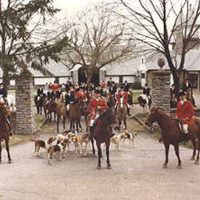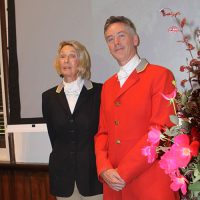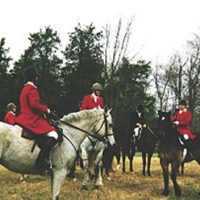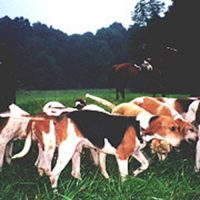The area now known as Indian Hill appealed to well-to-do families of the 1920’s because of the many advantages of country living — one of which was the sport of foxhunting. The Camargo Hunt was born about the same time that the Camargo Realty Company started selling land. Julius Fleischmann decided to build in the area in 1924 (Winding Creek Farm), and one of his first gestures was the donation of a pack of foxhounds to the Camargo Hunt. On the grounds of his farm, he built kennels, stables, and a cottage for the huntsman. Other prominent residents helped clear trails throughout the then densely forested area so that they might practice their sport.
Three years after its establishment in 1925, the Camargo Hunt was recognized by the Masters of Foxhounds Association. It was the 36th such hunt to be deemed worthy in the nation. By 1930, there were about 50 square miles of hunting country, including adjacent farms in Clermont and Warren Counties. The land over which the Camargo Hunt rode consisted of farms of its membership, as well as those farms whose owners had given permission for hunt usage. Native foxes, both gray and red, were pursued during the meets. The two decades between 1930 and 1953 are considered to be the heyday of foxhunting on Indian Hill. Later, the construction of highways and the subdivision of some of the larger farms made contiguous trails impossible. And, as the trails were severed by encroaching suburbia, the native foxes dwindled.
The Camargo Hunt moved to Clermont County in 1973 and utilized a Point Pleasant farm as headquarters for their sport. Then, in 1989 the Hunt moved to northern Kentucky to new expanded property with terrain similar to that of Indian Hill.
Although the founders of the Camargo Hunt are gone, avid huntsmen and women carry on the tradition of this glamorous sport. On Tuesdays and Saturdays from September through March, the members of the hunt meet, and under the leadership of their Master and their huntsman, marshal their hounds and prepare their mounts for the chase. Led by a pack of 25-40 dogs, the regally attired riders begin the pursuit of their elusive prey – the fox or coyote. The hunt usually takes between 2 – 4 hours, is physically demanding, and involves racing through the countryside, following hounds with their noses to the ground and their tails signifying their intensity of purpose.
According to a long time member of the Hunt, foxhunting originally was noted for its appeal to the landed gentry. Now love of the sport is the central attribute of the Camargo Hunt members, and some of the founders’ families can be seen dressed in Hunt garb today. The current diverse membership is notable for its commitment, and they all share a passion for their sport–the horses that they skillfully ride, the hounds they follow, the fresh air, the experience of the “chase,” and the sense of sharing with fellow fox hunters. This unique group of devotees is an integral part of Indian Hill’s history, with their equestrian fervor enriching the community.
Established members of the hunt earn the right to wear hunt buttons and Camargo Hunt colors. Emblazoned with the letters “CH”, the buttons are brass on the vest and bone on the coat. The colors, canary yellow and gray, are worn on the collar of the hunt jacket, and a yellow vest is worn. The awarding of Hunt Buttons to proficient riders occurs at a spring ceremony.
Before World War II, Camargo Hunt members hosted and attended elaborate Hunt Breakfasts and Hunt Teas, but now an era of informality reigns (with the exception of the annual Hunt Ball.) After a hunt, the physically energized riders are ravenous. Sometimes chili or cheese and crackers suffice, but tailgate parties after the hunt can be delicious.
An example of a memorable meal is the classic buffet “game dinner,” featuring smoked quail, rabbit, geese, and doves. One Hunt member is remembered for his traveling tenderloin and accompanying homemade horseradish sauce. Another is known for fruit-filled crepes, while a third’s legendary black bean soup elicits universal praise. Some rare items that have appeared as part of the post-Hunt feast are boiled tongue and watercress sandwiches. After an invigorating run through the country, appetites are hearty; and both the active and social members of the Camargo Hunt (about 140 currently) gather to consume marvelous morsels.




